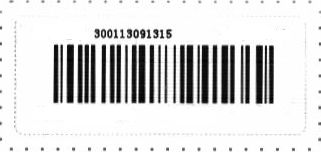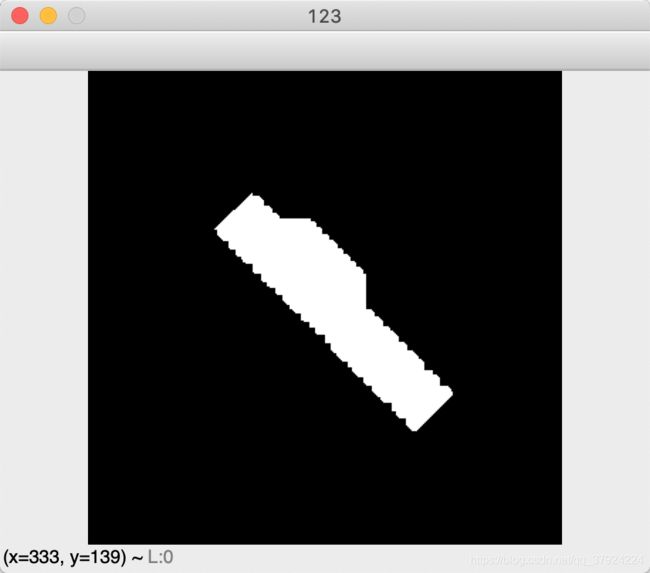前言
这周和大家分享如何用python识别图像里的条码。用到的库可以是zbar。希望西瓜6辛苦码的代码不要被盗了。(zxing的话,我一直没有装好,等装好之后再写一篇)
具体步骤
前期准备
用opencv去读取图片,用pip进行安装。
pip install opencv-python
所用到的图片就是这个
使用pyzbar
windows的安装方法是
pip install pyzbar
而mac的话,最好用brew来安装。
(有可能直接就好,也有可能很麻烦)
装好之后就是读取图片,识别条码。
代码如下
import cv2
import pyzbar.pyzbar as pyzbar
image=cv2.imread("/Users/phoenix/Downloads/barcode.png")
gray = cv2.cvtColor(image, cv2.COLOR_BGR2RGB)
texts = pyzbar.decode(gray)
for text in texts:
tt = text.data.decode("utf-8")
print(tt)
结果如图:
特殊情况处理(条码图片矫正和增强)
只以pyzbar举例
条码是颠倒的是否会影响识别?
不影响,单纯颠倒180度和90度是不会影响识别的。
我们把上一个图的颠倒180度,用颠倒后的图试一下
import cv2
import pyzbar.pyzbar as pyzbar
import numpy as np
image=cv2.imread("/Users/phoenix/Downloads/barcode_180.png")
gray = cv2.cvtColor(image, cv2.COLOR_BGR2RGB)
texts = pyzbar.decode(gray)
print(texts)
if texts==[]:
print("未识别成功")
else:
for text in texts:
tt = text.data.decode("utf-8")
print("识别成功")
print(tt)
结果如图
90度的话也是同样可以成功的。但是其它角度就会GG。
条码是倾斜的是否会影响识别?
会的,但这种还比较好处理。
如图
这张图用上面的代码就会
解决的思路是把这个图片旋转回来,至于如何判断转多少度,可以通过opencv来处理。通过膨胀和腐蚀将其变为如图。
接着再用cv2.minAreaRect函数,这个函数会返回如下,
里面的第三个-45就是我们需要的角度。
综合起来的实现代码,我就放在下面了。(我自己写的,如果有帮到你,快点关注和赞)
import cv2
import pyzbar.pyzbar as pyzbar
import numpy as np
def barcode(gray):
texts = pyzbar.decode(gray)
if texts == []:
angle = barcode_angle(gray)
if angle < -45:
angle = -90 - angle
texts = bar(gray, angle)
if texts == []:
gray = np.uint8(np.clip((1.1 * gray + 10), 0, 255))
angle = barcode_angle(gray)
#西瓜6写的,转载需声明
if angle < -45:
angle = -90 - angle
texts = bar(gray, angle)
return texts
def bar(image, angle):
gray = image
#西瓜6写的,转载需声明
bar = rotate_bound(gray, 0 - angle)
roi = cv2.cvtColor(bar, cv2.COLOR_BGR2RGB)
texts = pyzbar.decode(roi)
return texts
def barcode_angle(image):
gray = image
#西瓜6写的,转载需声明
ret, binary = cv2.threshold(gray, 220, 255, cv2.THRESH_BINARY_INV)
kernel = np.ones((8, 8), np.uint8)
dilation = cv2.dilate(binary, kernel, iterations=1)
erosion = cv2.erode(dilation, kernel, iterations=1)
erosion = cv2.erode(erosion, kernel, iterations=1)
erosion = cv2.erode(erosion, kernel, iterations=1)
contours, hierarchy = cv2.findContours(
erosion, cv2.RETR_EXTERNAL, cv2.CHAIN_APPROX_NONE)
if len(contours) == 0:
rect = [0, 0, 0]
else:
rect = cv2.minAreaRect(contours[0])
return rect[2]
def rotate_bound(image, angle):
(h, w) = image.shape[:2]
(cX, cY) = (w // 2, h // 2)
M = cv2.getRotationMatrix2D((cX, cY), -angle, 1.0)
cos = np.abs(M[0, 0])
sin = np.abs(M[0, 1])
#西瓜6写的,转载需声明
nW = int((h * sin) + (w * cos))
nH = int((h * cos) + (w * sin))
M[0, 2] += (nW / 2) - cX
M[1, 2] += (nH / 2) - cY
return cv2.warpAffine(image, M, (nW, nH))
image=cv2.imread("/Users/phoenix/Downloads/barcode_455.png")
gray = cv2.cvtColor(image, cv2.COLOR_BGR2GRAY)
texts = barcode(gray)
print(texts)
if texts==[]:
print("未识别成功")
else:
for text in texts:
tt = text.data.decode("utf-8")
print("识别成功")
print(tt)
条码是模糊的是否会影响识别?
会的,处理方法就是传统的调对比度,锐化。。。。
不过这个只能解决部分部分,至于有的条码,微信可以扫,支付宝可以扫,但是我们识别不了,这个也不能怪库不好,这部分该放弃就放弃吧。
结束语
如果你想用python来解决图像里的条码识别问题,这篇文章肯定是可以帮到你的。到此这篇关于详解利用python识别图片中的条码(pyzbar)及条码图片矫正和增强的文章就介绍到这了,更多相关python识别图片条码内容请搜索脚本之家以前的文章或继续浏览下面的相关文章希望大家以后多多支持脚本之家!






